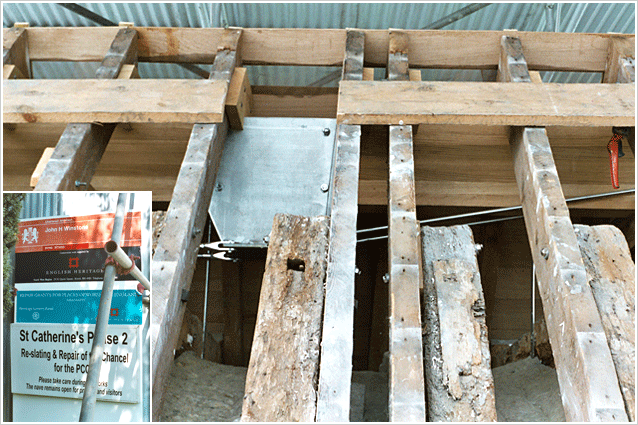Recent Examples from Portfolio
Photo:
Laminated Oak & stainless bow-string ridge beam threaded between ridge and medieval chancel barrel-vault
Church Roof Repair, St Catherines's Batheaston.
Only very seldom is a medieval church roof properly repaired with oak carpentary, and the diocese of Bath & Wells is no different to most in this regard.
The small parish accepted the need for English Heritage grant aid and this particular roof formed a second tranche
of grant in 2004. The medieval arch-braced chancel roof had been supplemented with a parallel nineteenth-century
roof to better take the loads of stone slates. Both roofs were failing under the weight of slipping stone slates
and the two constructions never effectively shared the loads of the roof covering. In addition the laths of the
medieval barrel vault were weakened by Death Watch beetle. To effect support secretly a laminated oak beam with stainless steel bowstring was inserted between the rafters in
short sections above the vault and below the ridge so each pitch spanned only from eaves to ridge.
A small medieval arch-braced roof such as this contains some 300 joints and the later roof a further150. Each joint was assessed and about 200 joints required repair.The
plaster vault was then rehung from the medieval roof after removal of the decayed laths, wool insulation laid in,the pitches boarded in oak, battened and new stone slates hung without felt.
In 2008 a final phase of repairs was carried out including the stone floor of the chancel; glass conservation; consolidation of historic roughcast and limewashing and cathodic protection of the C15 ferrementa of the east window. Such protection, enabling all parts of medieval ironwork to be preserved in-situ, may be the first use in a historic building on such a scale.
In 2008 a final phase of repairs was carried out including the stone floor of the chancel; glass conservation; consolidation of historic roughcast and limewashing and cathodic protection of the C15 ferrementa of the east window. Such protection, enabling all parts of medieval ironwork to be preserved in-situ, may be the first use in a historic building on such a scale.


